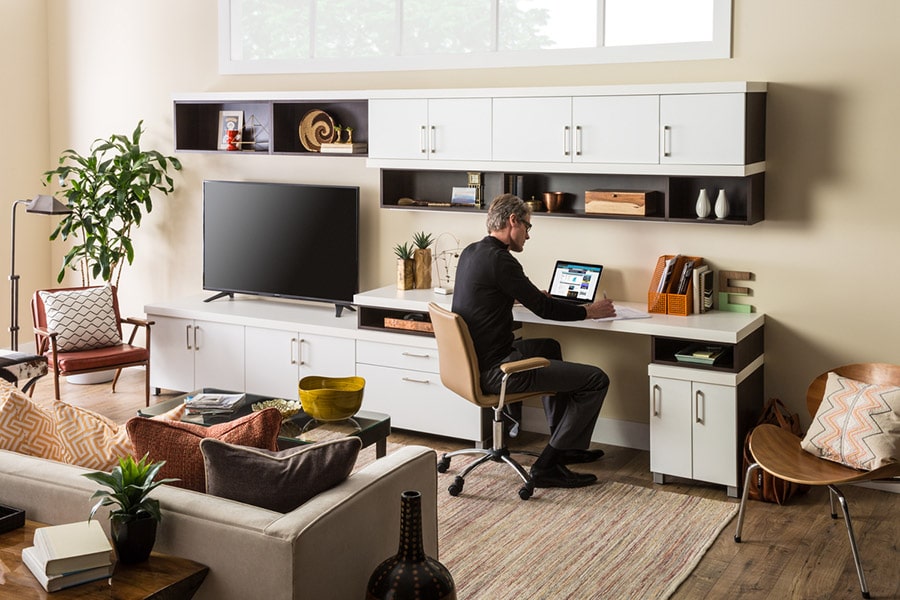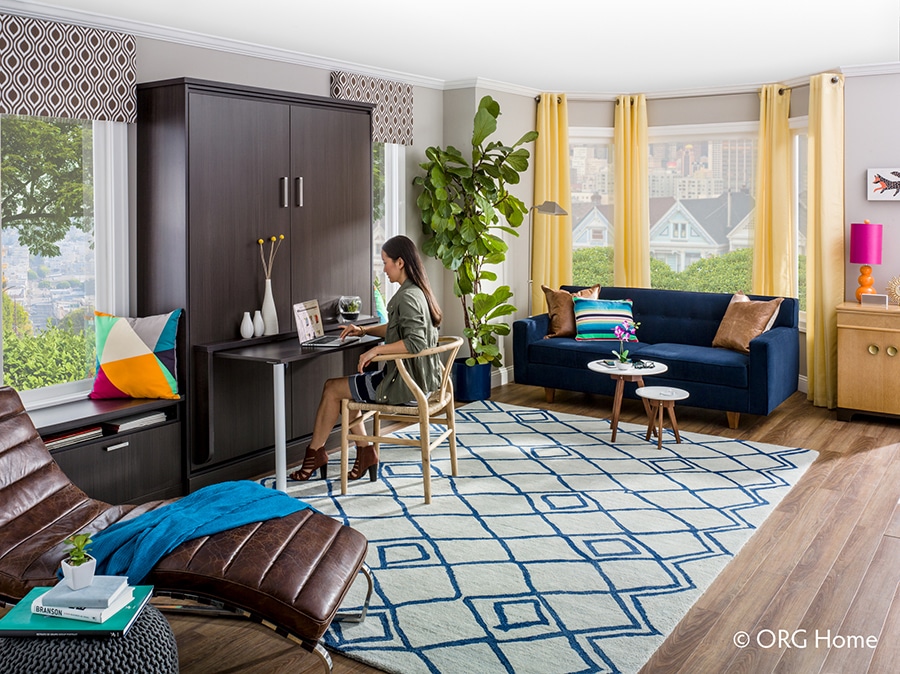7 Practical Alternatives to STOP Using Your Kitchen Table as Your Home Office

You thought working at home was going to be a short-term thing. But how wrong you were!
Although the Coronavirus reared its ugly, bacterial-filled head less than a year ago you’re still struggling to ‘be professional’ while working at your kitchen table. You know the drill by now.
- You’re dealing with the kid’s CONSTANT interruptions, squabbling and need for snacks.
- Your Zoom meeting with bowls of Cheerios in the background isn’t exactly screaming out ‘this is a person we NEED to promote!”
- And you know how challenging it is finding anything. Your kitchen table wasn’t designed with efficient storage in mind. Let’s face facts….
Work at home hasn’t exactly worked out as you planned. It’s frustrating…and it continues to be frustrating.
And now you’re struggling to find a better place for your home office. Your ‘temporary work at home’ status now looks like it will last indefinitely. But what better alternatives do you have than your kitchen table? And what – if you can take a moment to step back from the insanity which is your life – do you really need in a home office?
I understand your challenge. As a matter of fact I see your frustration constantly on design appointments I do for built in home office systems. And while it would be EXCELLENT if everyone could invest in a built-in home office (and it would be swell for my business as well) –this IS NOT realistic. Not everyone has the space, the budget, or need for a built in desk or storage system.
So, this brings me to two important questions.
Question 1 – What do you need in a home office? All home offices are not (and should not) be created equal. How you use this space and how often you need your home office will ‘drive the bus’ on your best alternative. So, to help you get your arms arounds what’s best for you, I’m going to give you 7 factors to prioritize your needs in Part 1.
Question 2 – What are the best alternatives FOR YOUR home office? How you work, what type of machine(s) you work on and what type of work environment you need to maximize your productivity are all key factors in choosing your best home office system. I’ll look at the 7 practical home office alternatives in Part 2 to help guide your decision.
Now with our 2 key questions in hand (or on paper in this case), let’s figure out how to blow up your kitchen table as a home office once and for all. First, I’ll look at 7 factors to choose the best home office alternative for you.
Part I– What do you need in a home office? 7 factors to guide your thinking.
While it would be wonderful to have plenty of space, and a big budget to create the grandest of home offices this is not your world. You need to be practical, yet – you want to be stylish. But before you worry about style, you need to get ‘real’ about your needs. These 7 factors will help structure your thinking around what home office solution is best for you:
Factor 1 – How much will you use this space?
If you need a home office sparingly being a ‘little cramped’ won’t kill you. However, if you’re cranking away day and night, an inefficient space will be a major blow to your productivity and comfort (says Captain Obvious).
Factor 2 – How much do you like to ‘spread out?”
While it’s cool envisioning yourself at a repurposed antique table or kitschy fold-down desk – if you’re a spreader (no, I’m not talking about peanut butter here) and LOVE, LOVE, LOVE to have papers EVERYWHERE while working, the ‘fun’ repurposed furniture route is not for you.

Factor 3 – What type of equipment do you use?
Do you prefer working on a small laptop, or is a super-sized desktop and humongous monitor your preferred choice? Will you need room for a printer? While shallow table-tops and furniture pieces look wonderful, they aren’t practical if your equipment will eat up all your worktop space.

Factor 4 – Do you need ‘quiet in the room?’
You may know someone who can concentrate in the middle of an earthquake. However, you (and your ADD) get distracted at the slightest interruption. If so – where your home office is located is even more important than the actual desk or surface, you use.

Factor 5 – Do you need to keep your families ‘paws’ (yes human and non-human) off your work papers, reports and binders?
While the ‘communal’ nature of a family can be wonderful, when it comes to keeping sensitive documents, folders, and binders from being disturbed this is where storage (and especially secure storage) is critical.
Factor 6- Do you need natural light or wide-open spaces?
Do you get depressed in dark spaces? Or conversely does ‘seeing the light of day’ prevent you from focusing? This question has a big impact whether you want your home office located in a light-filled loft or bedroom or a dark nook or your basement.
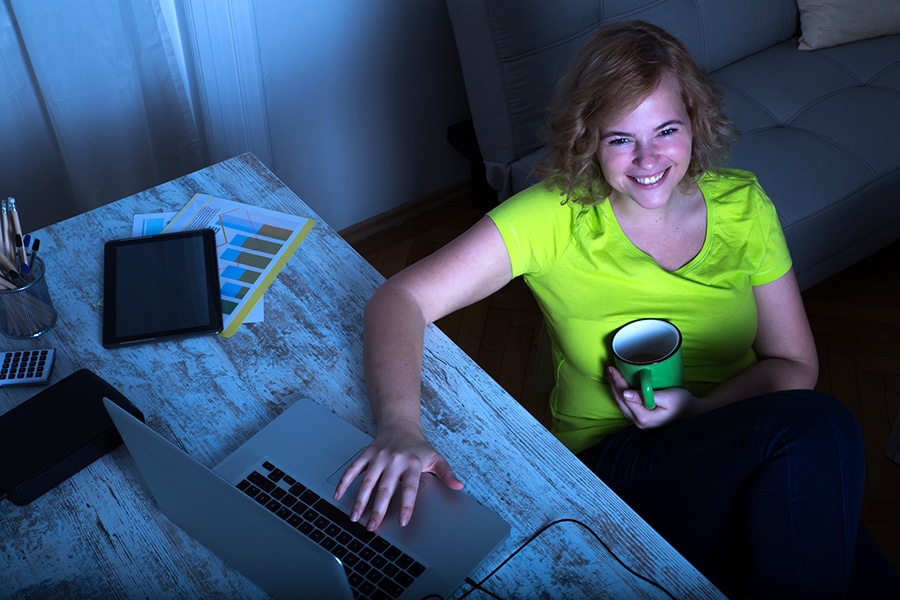
Factor 7 – Do you have power in all the wrong places?
Electrical outlets don’t seem like a big thing until you’re fishing wire halfway across the room to charge and power up your desktop, laptop and printers. You don’t want more ‘spaghetti’ (‘er wires) in your work area than you eat at your favorite Italian restaurant. While outlets can be moved or added, most electricians won’t do this for you for FREE! Efficient access to power and lighting needs to be a component in your decision.
So, now that we’ve looked at 7 key factors to help guide your home office needs, let’s look at 7 alternatives to find a better place to work at home than your messy and sticky kitchen table.
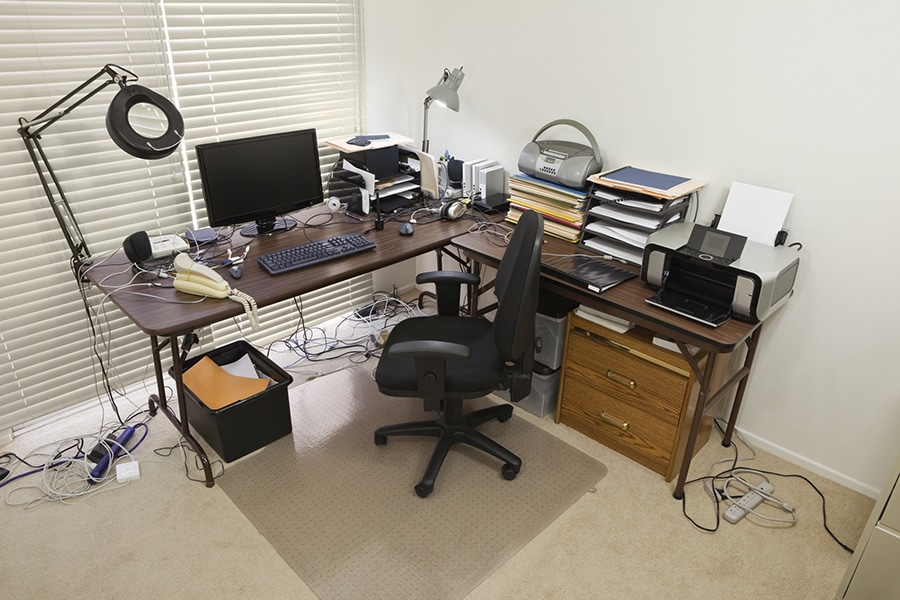
Upstairs home office with chaos of cords.
Part II– 7 alternatives to your kitchen table for a home office you’ll actually love
Alternative #1 to your kitchen table home office – The floating worktop
Floating worktops (like this angular cherry design made by my late Father in Law Luigi – and yes, our family is just ‘a little’ Italian) shows how small home offices can not only be space-efficient, but architecturally interesting as well.
If you know someone skilled in trim carpentry, and don’t need storage for files and supplies, the floating worktop can be a fun, functional and space-efficient home office alternative.
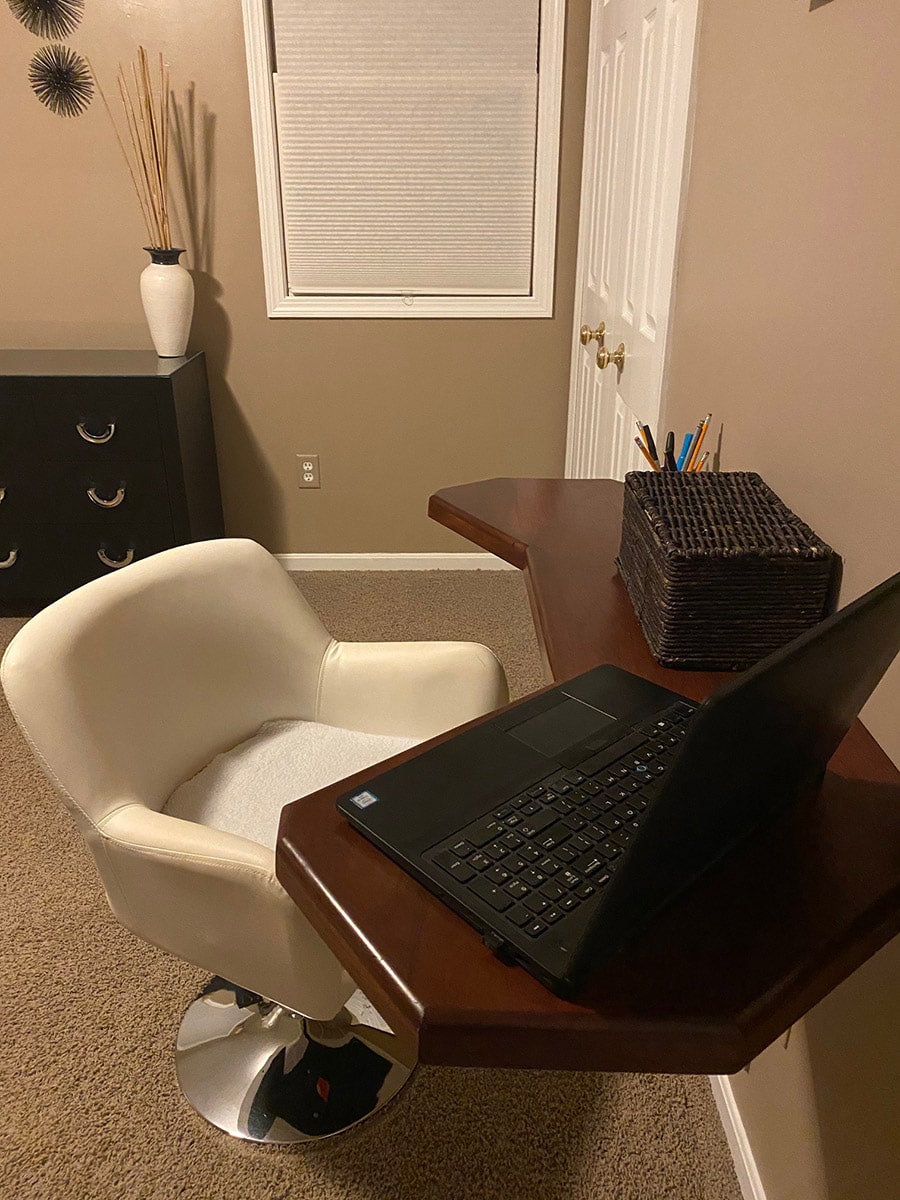
Alternative #2 to your kitchen table home office – The ‘desk on a diet…. AKA the fold up desk’
For occasional use in any room in the house (OK – I’d rule out using this option in your bathrooms), the fold up desk is the ultimate space saver. Put it down to work. Move it up for more space in the room.
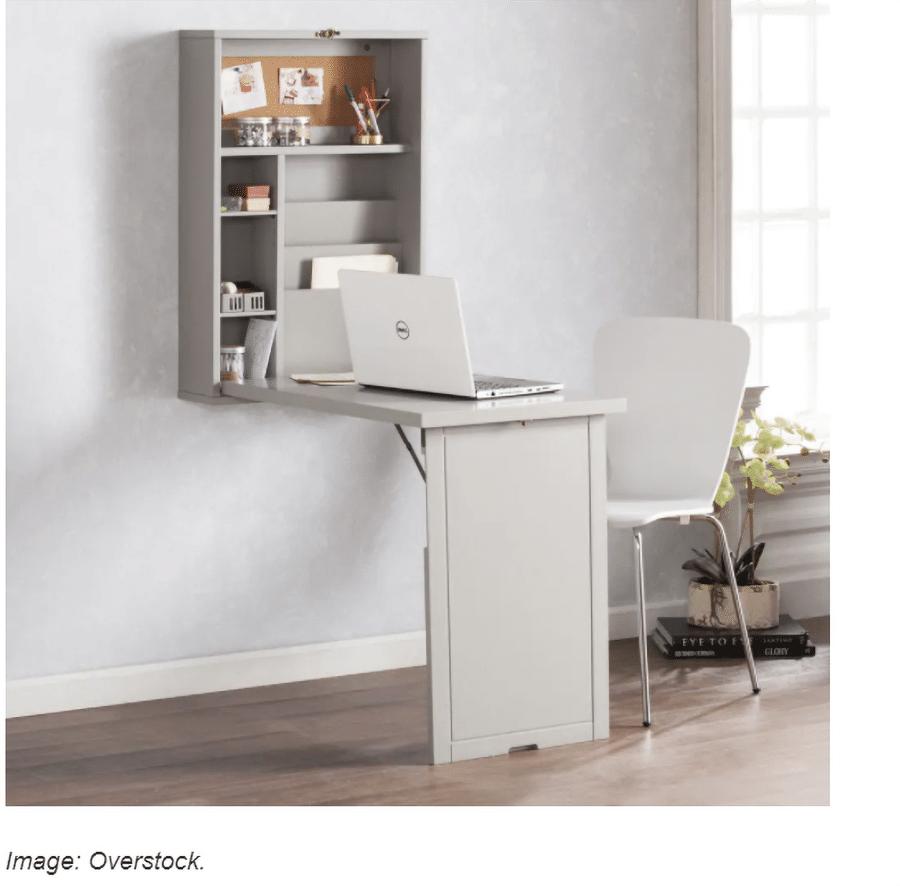
Image Source: overstock.com and SheKnows.com
However, if you like to spread out and DO NOT like ‘packing up’ your stuff at the end of each workday, the fold up desk may not be for you.
Alternative #3 to your kitchen table home office – Built-in home office cabinetry
The built in desk and home office system offers three important benefits. First, it can be designed around your needs and around your outlets, switches, windows, and doors. Second, it can provide a professional background for your #WayTooFrequent Zoom meetings. Third, it can provide much needed storage around your desk or worktop.
For the heavy home office user, built-in home office cabinetry is the ultimate. Of course, its drawback is it’s not the cheapest alternative on the list and can’t be moved.
Alternative #4 to your kitchen table home office – Consider movin’ on up (but not to a deluxe apartment in the sky, like The Jefferson’s, but to your attic) or movin’ on down to your basement
If this pandemic has made you feel Space-constrained you’re not alone (yes, that bad pun was intended).
It can be near-impossible to find a quiet space when your home is filled to the brim with people, pets, and possessions. You’re scratching your head asking (or ‘verbalizing’ while screaming at the kids), “WHERE can I find a quiet place to get some work done?” And the kitchen table – which is the epicenter of family life, is arguably the WORST PLACE to make this happen.
Two better options (if your home has them) can be to look up (to the attic) or look down (to the basement) as possible home office landing spots. And here’s why these locations make sense.
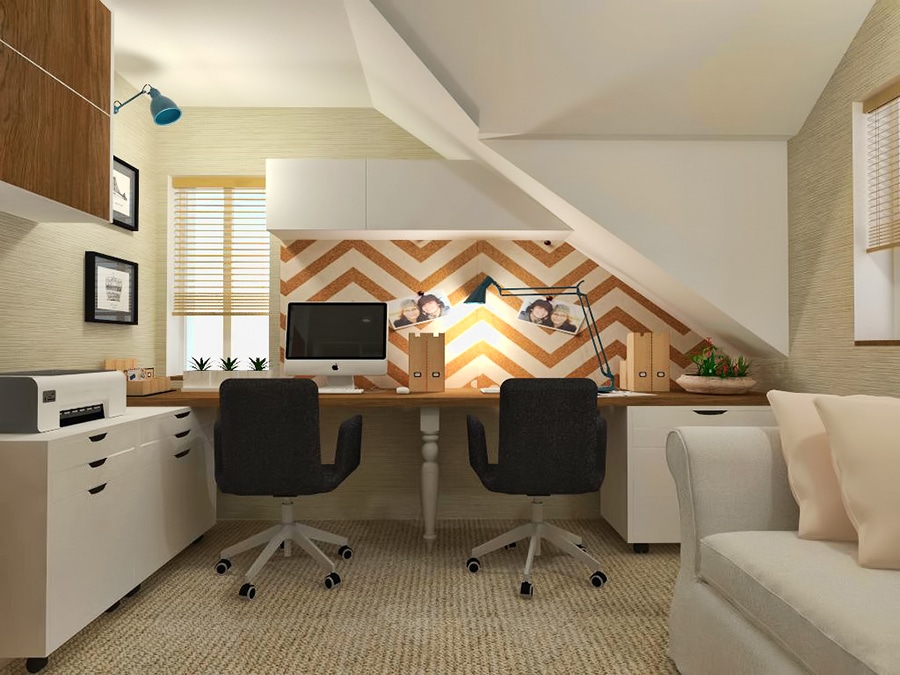
Image Source: Black Fox Interiors
The first reason is it’s more cost-effective to ‘add into’ your home (through remodeling your basement or attic) than to ‘add onto’ your home with a room addition.
The second reason is because these spaces are a ‘set of stairs’ away from the ‘action’ (which also might be known as when the kids are fighting or you can’t muffle your spouse’s booming voice!). You’re separated from the rest of the family by a door. Thank God you have an escape and get some sorely needed privacy.
While these floors represent HUGE opportunities to find space, in most cases they aren’t ‘workable’ (yes – another bad pun) without a pretty sizeable investment. But they’re certainly possible locations for your home office to consider.
Alternative #5 to your kitchen table home office – Repurposing your spare bedroom. Using a Murphy bed or Murphy desk bed to free up space.
The tiniest bedroom in your house is the spare bedroom. Then you added a comfortable – yet doggone big – Queen bed so your occasional (and non-existent right now) house guests have a nice place to sleep.
Your spare bedroom, while comfortable, is now eaten up by a bed. And this bed is used – at most- a handful of times a year.
And here’s a little secret I’ll tell you. Rethinking the bed is the key for a future home office.
You see if you use a 100-year-old invention – the Murphy wall bed – you’ll free up space for a desk or possibly built in home office system AND have a comfortable space (with a thick or 10” or 11” mattress) for guests to sleep when they stay over.

What’s also nice about using the bedroom for a home office is you have a door which can be shut for your important meetings.
Alternative #6 to your kitchen table home office – The #Cloffice (the closet office)
While it would be swell to repurpose a guest bedroom, or use the basement or attic for a home office you may be saying, “Mike, I don’t have the luxury of ANY of these rooms in my house!” And the bigger the city you live in, the more likely this is to be your reality. So, where else can you find a nook to work?
This is where the hashtag #Cloffice began to grow. Carving out room inside a storage closet- especially one you can close off with curtains, bi-fold, or barn doors – while not optimal can help you get the job done. And it’s also nice many closets are inside a bedroom so there’s a door you can shut for meetings.
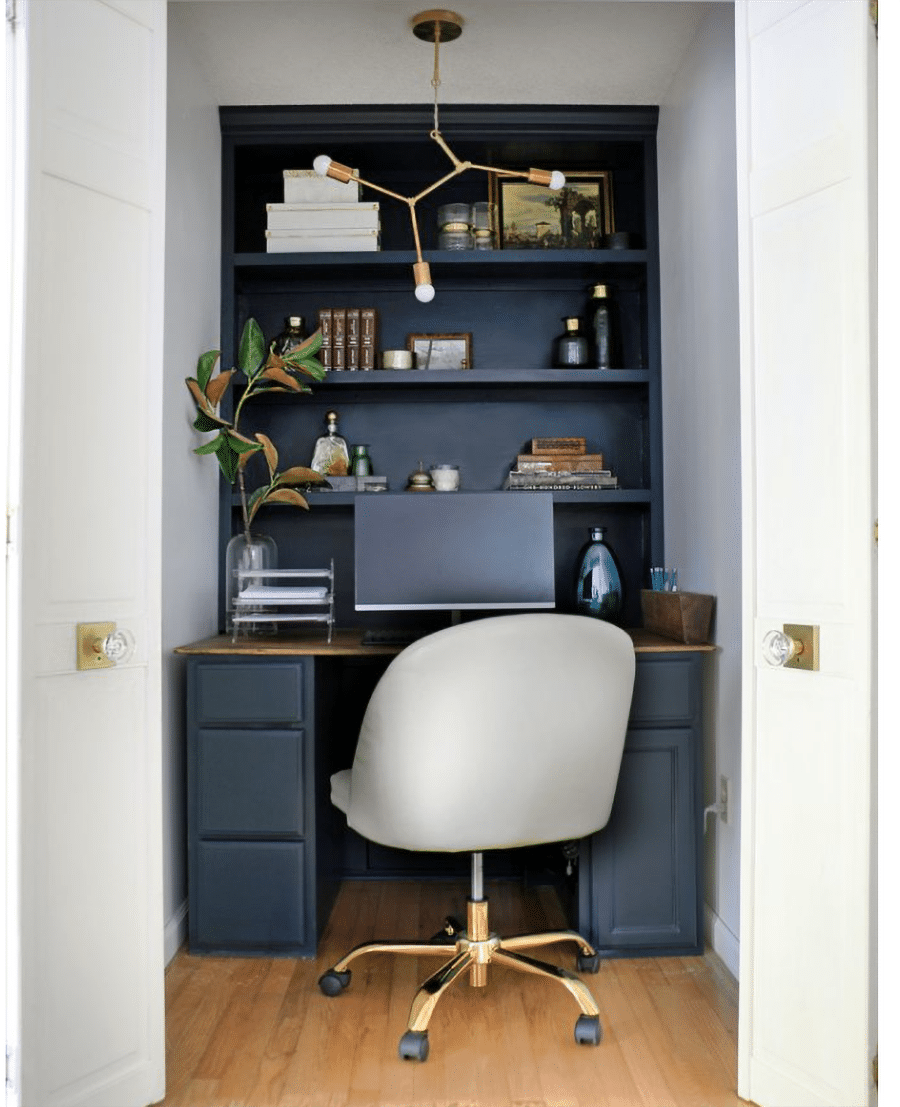
Image Source: www.homemadebycarmona.com
Alternative #7 to your kitchen table home office – The loft
While many builders and designers create loft spaces as family entertainment zones, you may need to get more practical and claim this space for work. What’s nice is lofts are often light-filled and spacious. However, privacy is one drawback to consider.
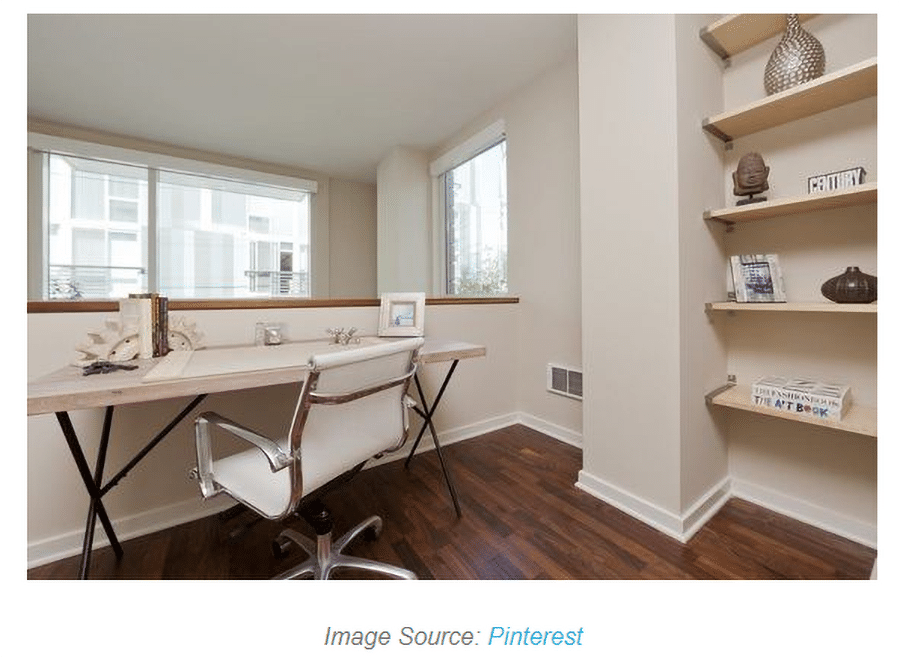
Image Source: www.interiordesire.net
How can I, my team and my network of home office design friends help you next?
While at the start of the pandemic ‘work at home’ was seen as a ‘part-time-fix’ to keep businesses going, this offsite work approach is being seen now by many employers as a smart business strategy (and a way to save costs) which is here to stay.
So, if your kitchen table ‘work at home’ workspace is not working for you, it’s no wonder. If there ever was a space in your home which WAS NOT designed for working, it’s the kitchen table. It’s noisy, it’s sticky, it reminds you of eating (which may not be best for your figure) and is in the center of everything!
However, if you’re stuck at the kitchen table today DO NOT give up hope. Start your planning process by first reflecting on what you need. Second consider alternatives (maybe one of the 7 mentioned above) which will make you more productive and (dare I say it) comfortable while working at home.
With all that I’ve said in this article I realize figuring out the optimal workspace can be tough if you ‘go it alone.’ And this is where me and my team would be honored to help (OK – yes – it’s the shameless plug coming now…).
If you’re in Columbus Ohio and are looking for a built-in home office or a Murphy bed to ‘liberate’ your spare room, we would love to help. Ask about a 3D home office design or call 614-545-6888 for a designer to help plan your space. If you’re not in Central Ohio, let me know where you live in the comments below and I’ll try to find you a referral through my nationwide industry association or friends in the home organization business.
Thanks for reading and putting up with my humor.
Mike
###
If you’d like more information about a custom home office in Columbus, garage cabinetry, pantry, entryway, Murphy wall bed or custom closet design (with a bit of bad humor thrown in for good…and bad…measure) follow me on LinkedIn @MikeFotiLinkedIn.
Tags: built in office Columbus, built-in cabinets Columbus, Columbus custom home office, Columbus interior design, custom home offices Columbus, home office design, home office design Columbus, home office ideas, home office ideas Columbus, home office in a basement, home office in an attic, home office mistakes, home office options, home office planning, home office planning Columbus, home office problems, home office storage, home office storage Columbus, home office workstation, Murphy bed, Murphy bed Columbus, New Albany home office, wall bed Columbus
